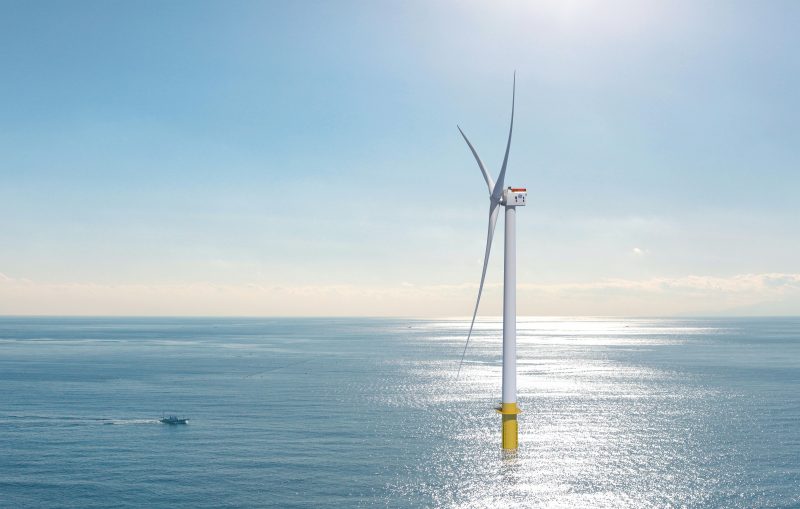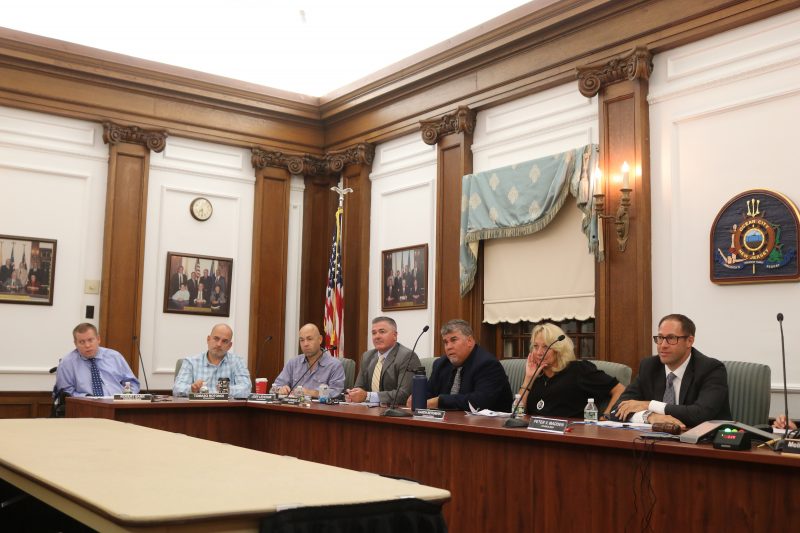City Council opposes Orsted's preferred route to run an underground transmission line through the city.
 By DONALD WITTKOWSKI
Ocean City plans to step up its fight against a proposed offshore wind energy farm during two upcoming public hearings that will represent a crucial regulatory showdown with the project’s developer.
The city has intensified its criticism of plans by developer Orsted, a Danish energy company, to run a transmission line under Ocean City’s streets to connect the offshore wind turbines to the land-based power grid at the former B.L. England Generating Station in Marmora.
Speaking during a City Council meeting Thursday night, City Business Administrator George Savastano outlined a strategy to attack Orsted’s proposal on several fronts during public hearings on Sept. 29 and Oct. 3.
In comments echoed by other members of the governing body, Councilwoman Karen Bergman said she is “happy” to see Ocean City stand up against the wind farm and the route Orsted is proposing for the transmission line.
“I’m excited to see that Ocean City is willing to fight and hope they will look at other avenues to go through,” Bergman said of the city’s desire for Orsted to consider other routes for the transmission cable.
The Sept. 29 hearing, open to the public, will include a Zoom session at 9 a.m. and then 5:30 p.m. held by the New Jersey Board of Public Utilities. The BPU is the state agency that is considering Orsted’s request to run a transmission line under the seabed and bring the electricity onshore in Ocean City through a cable at the environmentally sensitive beach lots of 35th Street.
Then on Oct. 3 at 6 p.m. at the Flanders Hotel at 11th Street and the Boardwalk in Ocean City, residents and other stakeholders are invited to a public hearing on the transmission line.
The hearing is on a Green Acres application to utilize the 0.647-acre portion of Ocean City-owned beach for the transmission cable, explained Liz Thomas, of Thomas/Boyd Communications, on behalf of Orsted’s project, known as Ocean Wind.
Thomas emphasized that the meeting will be for the purpose of public comment only. It will not be in a Q&A format.
By DONALD WITTKOWSKI
Ocean City plans to step up its fight against a proposed offshore wind energy farm during two upcoming public hearings that will represent a crucial regulatory showdown with the project’s developer.
The city has intensified its criticism of plans by developer Orsted, a Danish energy company, to run a transmission line under Ocean City’s streets to connect the offshore wind turbines to the land-based power grid at the former B.L. England Generating Station in Marmora.
Speaking during a City Council meeting Thursday night, City Business Administrator George Savastano outlined a strategy to attack Orsted’s proposal on several fronts during public hearings on Sept. 29 and Oct. 3.
In comments echoed by other members of the governing body, Councilwoman Karen Bergman said she is “happy” to see Ocean City stand up against the wind farm and the route Orsted is proposing for the transmission line.
“I’m excited to see that Ocean City is willing to fight and hope they will look at other avenues to go through,” Bergman said of the city’s desire for Orsted to consider other routes for the transmission cable.
The Sept. 29 hearing, open to the public, will include a Zoom session at 9 a.m. and then 5:30 p.m. held by the New Jersey Board of Public Utilities. The BPU is the state agency that is considering Orsted’s request to run a transmission line under the seabed and bring the electricity onshore in Ocean City through a cable at the environmentally sensitive beach lots of 35th Street.
Then on Oct. 3 at 6 p.m. at the Flanders Hotel at 11th Street and the Boardwalk in Ocean City, residents and other stakeholders are invited to a public hearing on the transmission line.
The hearing is on a Green Acres application to utilize the 0.647-acre portion of Ocean City-owned beach for the transmission cable, explained Liz Thomas, of Thomas/Boyd Communications, on behalf of Orsted’s project, known as Ocean Wind.
Thomas emphasized that the meeting will be for the purpose of public comment only. It will not be in a Q&A format.

 The proposed underground transmission line for the offshore wind energy farm would run through Ocean City and connect with a substation at the decommissioned B.L. England Generating Station (in background) in Marmora.
Orsted has proposed running 99 huge wind turbines 15 miles offshore from Atlantic City to Stone Harbor, passing by Ocean City in the process. The wind farm is currently in the planning and permitting phase and is scheduled for completion by 2024. Plans call for a 1,100-megawatt project that would create thousands of construction jobs and power over 500,000 homes.
Critics have assailed the project as an offshore “industrial park” that would harm the environment, marine life, the commercial fishing industry and the shore’s critical tourism industry. They also say the towering turbine blades would be a visual blight when viewed from shore.
“It affects all of our livelihoods,” said Michael DeVlieger, a former Ocean City councilman who is an outspoken opponent of the wind farm.
In comments at Thursday’s Council meeting, DeVlieger urged the public to participate in the Sept. 29 and Oct. 3 hearings to voice Ocean City’s opposition to the project.
“This community is against this project,” he said while also thanking the city for opposing the wind farm.
DeVlieger called the hearings “an obstacle” for Orsted as it pursues state permission for the transmission line.
“There’s a hundred reasons for us not wanting them to have it,” he said.
As he has done in the past, DeVlieger stated his belief that the wind farm would be detrimental to the environment, marine life, commercial fishing operations, Ocean City’s tourism and home values.
“We’re going to have an industrial park out there for the next 25 years,” he said.
The proposed underground transmission line for the offshore wind energy farm would run through Ocean City and connect with a substation at the decommissioned B.L. England Generating Station (in background) in Marmora.
Orsted has proposed running 99 huge wind turbines 15 miles offshore from Atlantic City to Stone Harbor, passing by Ocean City in the process. The wind farm is currently in the planning and permitting phase and is scheduled for completion by 2024. Plans call for a 1,100-megawatt project that would create thousands of construction jobs and power over 500,000 homes.
Critics have assailed the project as an offshore “industrial park” that would harm the environment, marine life, the commercial fishing industry and the shore’s critical tourism industry. They also say the towering turbine blades would be a visual blight when viewed from shore.
“It affects all of our livelihoods,” said Michael DeVlieger, a former Ocean City councilman who is an outspoken opponent of the wind farm.
In comments at Thursday’s Council meeting, DeVlieger urged the public to participate in the Sept. 29 and Oct. 3 hearings to voice Ocean City’s opposition to the project.
“This community is against this project,” he said while also thanking the city for opposing the wind farm.
DeVlieger called the hearings “an obstacle” for Orsted as it pursues state permission for the transmission line.
“There’s a hundred reasons for us not wanting them to have it,” he said.
As he has done in the past, DeVlieger stated his belief that the wind farm would be detrimental to the environment, marine life, commercial fishing operations, Ocean City’s tourism and home values.
“We’re going to have an industrial park out there for the next 25 years,” he said.
 City Council opposes Orsted's preferred route to run an underground transmission line through the city.
In other business Thursday, Savastano said that the city is planning to take a closer look at its zoning laws this fall to see if there are ways to create more parking.
In particular, Savastano noted that many garages at homes in town are being used for storage instead of parking. Cars that should be using the garages are instead taking up street parking, adding to the city’s parking shortages.
The city will also explore whether homes that have been elevated to protect them from flooding offer an opportunity to create parking spaces underneath them, Savastano said.
Some members of Council and the public said the zoning laws should be changed to require more parking at large, new homes when they are built.
Councilman Jody Levchuk said he will “absolutely not” support allowing seven-bedroom homes to have just one parking space, for instance.
“I have an issue with seeing a seven-bedroom home with one parking spot,” Levchuk said.
City Council opposes Orsted's preferred route to run an underground transmission line through the city.
In other business Thursday, Savastano said that the city is planning to take a closer look at its zoning laws this fall to see if there are ways to create more parking.
In particular, Savastano noted that many garages at homes in town are being used for storage instead of parking. Cars that should be using the garages are instead taking up street parking, adding to the city’s parking shortages.
The city will also explore whether homes that have been elevated to protect them from flooding offer an opportunity to create parking spaces underneath them, Savastano said.
Some members of Council and the public said the zoning laws should be changed to require more parking at large, new homes when they are built.
Councilman Jody Levchuk said he will “absolutely not” support allowing seven-bedroom homes to have just one parking space, for instance.
“I have an issue with seeing a seven-bedroom home with one parking spot,” Levchuk said.